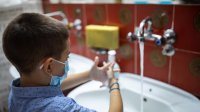8 Tips to Support Hand Hygiene in Preschool
A good handwashing routine is a must for health and can also help preschool students develop valuable skills.
Your content has been saved!
Go to My Saved Content.Four-year-old Michael is playing in the block area of his preschool classroom. He wipes his runny nose on his sleeve. A teacher calls from across the room, “Michael, go wash your hands!” He goes to the sink and stands on tiptoe to reach the cold water faucet, which he turns on full blast. He puts his other hand under the running water, and it sprays everywhere. He leaves the water running, wipes his hand on his shirt, and runs back to his block building.
We all know that handwashing helps prevent the spread of germs and keeps everyone healthier. It also can help children develop cognitive, communication, motor, social and emotional, and adaptive skills. However, this important routine often gets rushed or is overlooked.
Healthy development in early childhood provides the building blocks for future academic and societal success. By integrating a robust handwashing routine in preschool, we can support children in reaching key early learning milestones.
Setting Up a Handwashing Routine
1. Designate one staff member (or a trained volunteer) as the daily handwashing overseer: This adult should be available throughout the day to supervise and assist children with the handwashing routine. Children thrive with adult support and encouragement. They also need time and space to explore and learn independently. Handwashing shouldn’t be rushed. The supervising adult can provide a patient framework for this powerful routine.
2. Have easily accessible sinks at the children’s level: If they must use adult-size sinks, have sturdy, slip-resistant step stools available. Climbing onto a stool can help develop gross motor skills. Rolling up their sleeves, turning faucets on and off, getting a squirt of soap, and drying their hands are wonderful opportunities to promote adaptive motor skills.
3. Post a clear visual diagram depicting the hand hygiene sequence by the sink at the children’s eye level: Have soap and paper towels within easy reach. Make sure there’s a trash can nearby. This sets children up for success and enables them to more easily internalize the structure of the routine. Have a visual timer available at the sink. Children can learn to set the timer for 20 seconds before starting to wash their hands. This is fun and encourages independence.
4. At circle time, children can pretend to wash their hands for 20 seconds: Model and practice rubbing the “soap” on the top of their hands, on the bottom of their hands, between their fingers, and under their nails. “Can you wash fast, then slow? Hands up high, now down low!” These are a few of the early learning concepts we can target. Later, while washing their hands at the sink, children can practice those concepts with real soap and water. We can also explore sensory concepts like slippery, bubbly, sudsy, warm, cold, and more.
5. Sing a song or count while lathering hands: Children love songs and repetition. Choose simple, soothing songs for handwashing, like “Twinkle, Twinkle, Little Star," which takes about 20 seconds to sing. Or you can make up your own songs. Sing the songs as a group at circle time. Then, children can sing them independently at the sink. These dual activities can help foster language and cognitive development.
6. Read books with your class about germs and how proper hand hygiene helps us stay healthy: The site Childhood 101 has some suggestions, including Germs Are Not for Sharing, by Elizabeth Verdick, which addresses other healthy habits along with handwashing and has inclusive illustrations, and Wash Your Hands, by Margaret McNamara, which includes a simple handwashing song.
7. When it’s necessary for a larger group of children to take turns at the sink, have more than one adult available to assist: Offer options for the children waiting their turn. S’cool Moves is one resource that provides visual posters with a variety of moves that children can do while waiting. Or lead the children in a simple game such as I Spy to practice colors or Simon Says to reinforce body-part vocabulary. Make this waiting time an opportunity to engage children in a fun, calm learning activity.
8. Children look to adults as role models: It’s very influential for them to see the adults around them taking the time to correctly wash their hands when necessary. Not only is handwashing important at school, but children should also do it consistently at home. Support parents and caregivers in establishing this routine with their children. Provide the same visuals and songs you use at school for them to use at home, with links to videos, stories, and activities that promote hand hygiene as a family endeavor, such as the Centers for Disease Control and Prevention’s When and How to Wash Your Hands.
Teaching children to wash their hands should be an engaging priority, not a chore. Handwashing is a valuable life skill that can develop early learning competencies, removes germs, and helps prevent the spread of illness. Consistently promoting this healthy habit in preschool is one of the most important things we can do.
